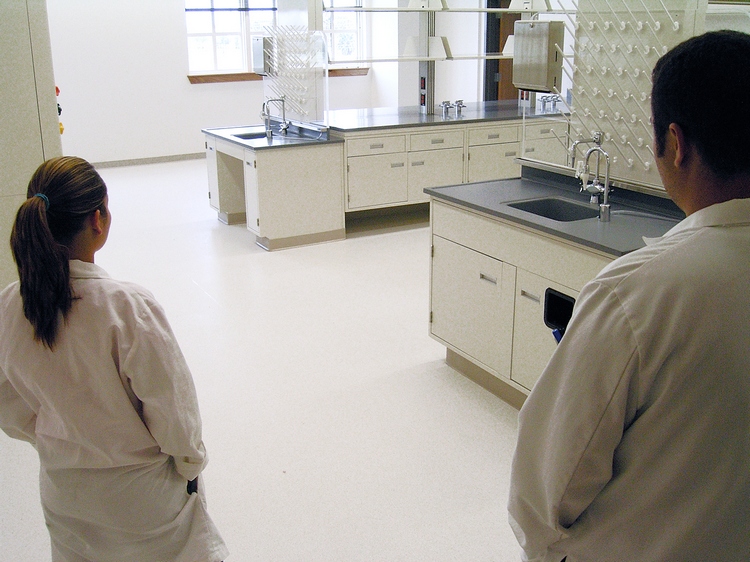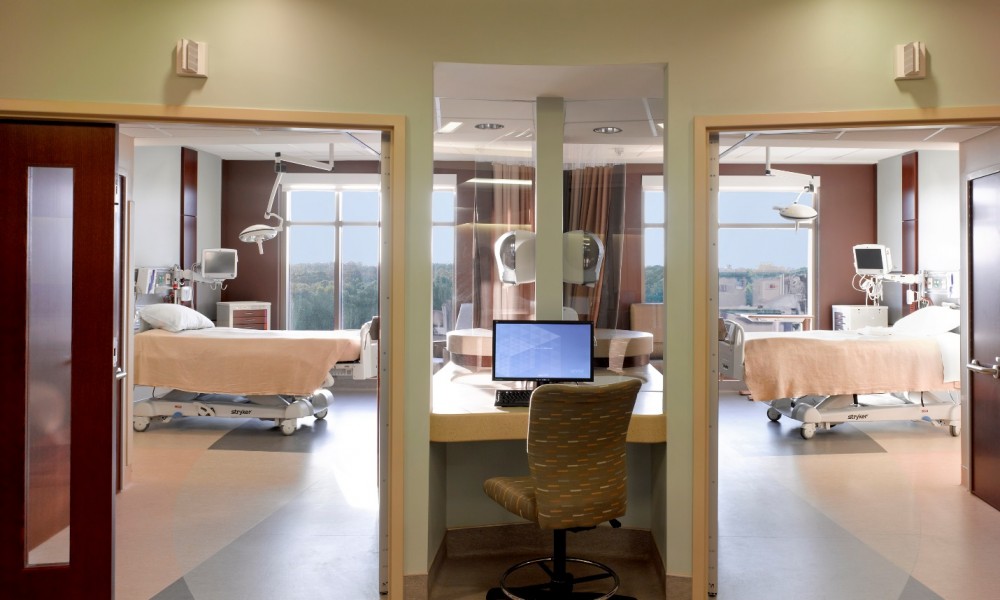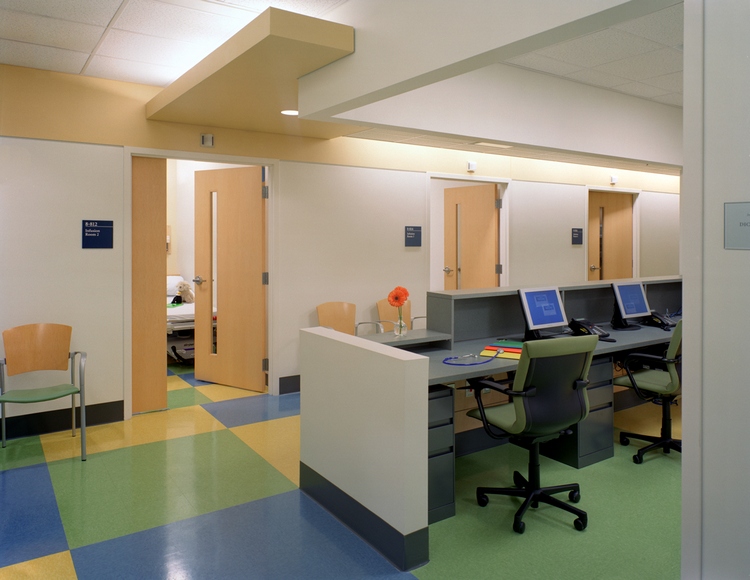 Texas A&M Pharmacy at the Irma Lerma Rangel College of Pharmacy.
Texas A&M Pharmacy at the Irma Lerma Rangel College of Pharmacy.
 Piedmont Newnan Hospital Inpatient Unit.
Piedmont Newnan Hospital Inpatient Unit.  Massachusetts General Hospital Yawkey Nurse Station.
Massachusetts General Hospital Yawkey Nurse Station. Subscribe Now
Ergonomics + Safety
Factoring in ergonomics in today’s facilities to keep workers, patients safe
In 2013, Dr. Alan Hedge from Cornell University presented a fantastic presentation on ergonomics in healthcare. He is a recognized expert on the subject, and provides public access to his research and insights at http://ergo.human.cornell.edu.
Dr. Hedge’s presentation sparked the interest of many, and there has been a trend of presentations on the topic since then. Issues of ergonomics in healthcare are more than just fascinating; they are crucial to delivering effective patient care.
There are many human factor-related dangers in healthcare and these dangers impact the healthcare workforce. Shortages in physicians, nurses and other types of care providers in healthcare are a commonly publicized issue. Some sources predict that by 2025, there will be a shortfall of 160,000 doctors and 260,000 nurses. As the U.S. healthcare system can’t afford to lose a single healthcare provider, it is important to identify ways to protect the well-being of current providers so they can remain productive longer. Healthcare facilities can play a key role.
A few human factor-related dangers in healthcare and the impact that designers may have on reducing these dangers are:
- Exposure to hazardous medications, such as chemotherapy. These exposures have been linked to reproductive issues and cancer. The latest guidelines in pharmacies is expected to be released in October 2014, USP 800. This new chapter of USP addresses separation of hazardous and non-hazardous drugs, and identifies processes to provide a safer work environment for pharmacists.
- Neck and back injuries are becoming more common with the increased use of computers. One of the factors contributing to these injuries includes workstations that are not adjustable based on the size of the person using the workstation; for example, chairs and monitor heights that are not adjustable. Worse yet, many of the workstations are adjustable, but the care providers were never taught how to use the devices, so they don’t adjust them. These injuries aren’t only associated with computers. Some care providers are using tablets that may be heavy and are set on flat surfaces, and injuries such as “iPad neck” and “touchscreen finger” have been reported from use of such devices. Consideration for technology, including how, when and where technology will be used is a key to designing an ergonomically correct and safe healthcare facility.
- Obese patients are another risk. In 2010, the Centers for Disease Control and Prevention reported that over 35 percent of American adults are obese. This presents a challenge for healthcare workers because of the neck and back injuries associated with lifting and moving heavy patients. The latest FGI 2014 guidelines include specific recommendations and considerations for the design of facilities to support obese patients and visitors. These recommendations affect the selection of medical equipment including patient lifts, size of the patient room, selection of furniture and specifications for fixtures.
- Long travel distances can be hard on care providers’ joints. Some flooring surfaces are better at cutting the risk of infection; however, softer surfaces absorb shock from care providers’ joints. Exploring the various options and the research related to those options, outside of just the first cost and operational cost, can lead to specification of healthier materials for patients and staff. Creative designs can minimize travel distances for care providers. Careful consideration must be given to placement of supplies. Some clients have set guidelines that 90 percent of what a nurse needs is within 10 seconds’ walking distance.
- Hospital-acquired infections afflict 2 million people each year—one in every 20 patients. Designers can impact this by using antimicrobial products on surfaces, such as copper on grab bars, door handles and light switches. Placement of the sink at the entry/exit to a room has also been shown to have an impact on care provider compliance with hand hygiene.
- Patient slips and falls can be reduced with choices in flooring, and installation of grab bars in the restroom. Caregiver visibility to patients can also contribute to reductions in slips and falls, as the caregiver can see when the patient is trying to get out of bed and can assist the patient.
- Lighting is another opportunity for injury. Care providers perform many different tasks and need varying levels of lighting for each. A bright exam light may be great for inserting an IV; however, that same bright light isn’t as effective for viewing the monitor on a computer. Lighting needs to be adjustable and moveable. Heat is another issue associated with lights, and most welcome LED lights because that issue is eliminated. Lighting is a key detail that must be considered in the design of a healthcare facility. Medication errors can be reduced by providing appropriate lighting, designing spaces to prepare medications where nurses will not be distracted or interrupted, reducing noise levels and standardizing locations of supplies so that nurses have what they need at the point of use. Access to natural light is healing for everyone, not just patients. Studies have shown a more rapid rate of healing in patients with access to natural light. Productivity improvements have been demonstrated for workers with access to the natural light.
Healthcare designers have a great opportunity to make an impact on the safety of the healthcare environment. Ergonomics impacts the design through consideration of handling of hazardous medications, design of workstations to minimize the risk of neck and back injuries, accommodations to support care providers in caring for obese patients, specification of flooring that reduces infection risks while also being easy on care provider’s joints, and selection of adjustable lighting.
Photos courtesy of Perkins + Will.
Tags: Architecture, Engineering, Ergonomics, Safety
Posted September 17, 2014
More Articles:
- Coverings 2024
Apr 22, 2024 – Apr 25, 2024 - Hospital, Outpatient Facilities & Medical Office Buildings Summit
Apr 25, 2024 – Apr 25, 2024 - CxA Workshop & Exam
Apr 29, 2024 – Apr 30, 2024 - EMP Seminar & Exam at CxEnergy 2024
Apr 29, 2024 – Apr 30, 2024 - CxEnergy
Apr 29, 2024 – May 2, 2024 - PHCC West 2024
Apr 29, 2024 – May 2, 2024 - Lean in Design Forum 2024
May 1, 2024 – May 2, 2024











